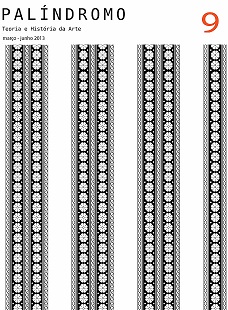A MEMÓRIA DO CARTÃO E A POTÊNCIA DA TAPEÇARIA
DOI:
https://doi.org/10.5965/2175234605092013247Palavras-chave:
tapeçaria , imagem , cartão , potência/acontecimentoResumo
Nesse encontro pretende-se apresentar algumas dúvidas que ficaram ao final da dissertação “As Tramas dos Tapeceiros Narradores: Técnica e Criação” e alguns tópicos assinalados pela orientação naquela ocasião. Nos últimos quatro anos, relendo e ampliando o repertório bibliográfico, surgiram novos enfoques para discutir essas interrogações e principalmente nortear uma possível continuação da pesquisa. Esta tem por objetivo analisar um conjunto de imagens de tapeçarias de diferentes períodos da história juntamente, quando possível, com as pinturas ou desenhos e os cartões que lhe deram origem. Implica ainda em perceber essa sequência de atividades e assim poder avaliar se o cartão carrega consigo a memória da pintura, e por outro lado se a tapeçaria tem sua própria potência para que esta obra se torne o acontecimento. Inicialmente o conjunto de imagens que servirão como referência para analisar as demais tapeçarias contemporâneas é uma série produzida entre 1370/80 denominada O Apocalypse. A outra série de tapeçarias, produzida a partir de desenhos do artista francês Jean Lurçat, em meados do século XX, denominadas Le Chant Du Monde também será um importante referencial. No Brasil a pesquisa buscará as tapeçarias feitas a partir de pinturas do paisagista Roberto Burle Marx. Os tapeceiros contemporâneos Archie Brennan, Sarah Swett e Jean Pierre Larochette foram escolhidos pela relevância de seu trabalho, diferentes formações e processos de produção. Como se relacionam com os eventos de arte contemporânea e quais as preocupações com a produção da tapeçaria na contemporaneidade.
Downloads
Referências
ALBERS, Josef. A Interação da Cor. São Paulo: Martins Fontes, 2009. BARTHES, Roland. A Câmara Clara. Rio de Janeiro: Nova Fronteira, 2011.
BENJAMIN, Walter. Obras Escolhidas: Magia e Técnica, Arte e Política. São Paulo: Brasiliense, 1996. BENJAMIN, Walter. A Obra de arte na era de sua reprodutibilidade técnica. In: BENJAMIN, Walter. Magia e Técnica, arte e política. São Paulo: Brasiliense, 1996.
CAVALCANTI, Lauro e EL-DAHDAH Fares (orgs). Roberto Burle Marx 100 Anos: A Permanência do Instável. Rio de Janeiro: Rocco, 2009.
CHEREM, Rosângela Miranda. Imagem – Acontecimento. PPGAV- UDESC, 2009 (no prelo).
DELEUZE, Gilles. Diferença e Repetição. São Paulo: Graal, 2006.
DELEUZE, Gilles e GUATTARI, Felix. Mil Platôs, Capitalismo e Esquizofrenia. Rio de Janeiro: editora 34, vol. 5, 2007.
DELEUZE, Gilles. Francis Bacon – Lógica da Sensação. Rio de Janeiro: Jorge Zahar, 2007.
DERRIDA, Jacques. Pensar em não ver; escritos sobre as artes do visível (1979- 2004). Florianópolis: UFSC, 2012.
DIDI-HUBERMAN, Georges. O que vemos, o que nos olha. São Paulo: Ed. 34, 1998. DIDI-HUBERMAN, Georges. Ante el tiempo. Argentina: Adriana Hidalgo, 2006.
FOCILLON, Henri. Vida das Formas. Rio de Janeiro: Zahar, 1983.
JARRY, Madeleine; COHEN, Harold; BRENNAN, Archie; HODGE, Maureen et al. Master Weavers: Tapestry from Dovecot Studios 1912-1980. Edimburgh: Canongate, 1980.
LEENHARDT, Jacques. (org.) Nos Jardins de Burle Marx. São Paulo: Perspectiva, 2006.
KRAUSS, Rosalind. La Originalidad de la Vanguardia y otros mitos modernos. Madrid: Alianza Editorial, 2002.
Downloads
Publicado
Como Citar
Edição
Seção
Licença
Copyright (c) 2013 Elke Hulse

Este trabalho está licenciado sob uma licença Creative Commons Attribution 4.0 International License.
DECLARAÇÃO DE DIREITOS AUTORAIS
a. Os artigos publicados pela revista são de uso gratuito, destinados a aplicações acadêmicas e não comerciais. Todos os direitos autorais são atribuídos à revista. Os artigos cujos autores são identificados representam a expressão do ponto de vista de seus autores e não a posição oficial da Revista Palíndromo. O (s) autor (es) compromete-se sempre que publicar material referente ao artigo publicado no Palíndromo mencionar esta publicação da seguinte forma:
Este artigo foi publicado originalmente pela revista Palíndromo em seu volume (coloque o volume), número (coloque o número) no ano de (coloque o ano) e pode ser acessado em: http://www.revistas.udesc.br/index.php/palindromo
b. Plágio, em todas as suas formas, constitui um comportamento antiético de publicação e é inaceitável. A revista Palíndromo utiliza o software iThenticate de controle de similaridade


